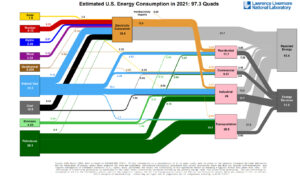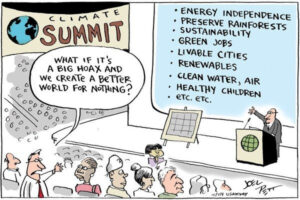The world runs on energy. All different types of energy: oil, gas, coal, solar, wind, nuclear power, even gravity. We measure energy in different ways. We use joules and calories for food, kilojoules or British Thermal Units (BTUs) for fossil fuels like coal or oil. Electrical energy is typically measured in kilowatt hours (kWh). An average Australian household will use about 20 kilowatt-hours of electricity a day1.
Of course, all forms of energy could be measured in kilowatt hours. At the country level we measure energy in Terawatts hours, a Terawatt being a trillion watts or a billion kilowatts. According to the International Energy Agency (IEA), in 2020 the world consumed approximately 150,000 Terawatt-hours (TWh) of energy2.
Most of the energy we produce we waste. According to analysis by the Lawrence Livermore National Laboratory based on US Department of Energy (DOE), Energy Information Administration (EIA) data, of the 97.3 quads of energy produced in the US (a quad is 1 quadrillion BTUs which is equivalent to 293 Terawatt hours), 67% is ‘rejected energy’.
Figure 1 US Energy Flows 2021 – Lawrence Livermore National Laboratory

Source https://flowcharts.llnl.gov/sites/flowcharts/files/2022-04/Energy_2021_United-States_0.png
‘Rejected energy’ means the system does not use the energy for the purpose for which it was generated.
An internal combustion engine (ICE) car is a system that gets you from A to B. But only about 20% of the energy stored in the petrol you use to power your car is used to get you from A to B and the rest is ‘rejected’ in the form of heat, braking and transmission drag3. (In contrast an average electric vehicle is around 77% energy efficient.4
Electricity generation is also not perfectly efficient. Coal-fired power stations take time to ramp up or down, so they produce energy during the day when everyone needs it, but they also produce energy in the middle of the night, when it is not needed. They also waste a lot of energy to heat and cooling. Solar panels produce electricity when the sun is shining and wind turbines when the wind is blowing, which means the electricity is intermittent and not responsive to demand. On top of that, transmission systems are typically only around 70 – 85% efficient.
For most of history we have used energy in independent and separate systems. We use electricity to light our houses, we cook with gas, we put petrol in our cars, industries run on coal. How much more efficient would our energy use be if all our systems ran on one type of energy? What if the energy lost when we hit the brakes could be used to heat our homes? What if the power generated at night could be stored for use during the day? What if we produced energy closer to where we used it? What if we electrified everything?
A climate change emergency, an incredible opportunity
Source Joel Pett – Lexington Herald
Despite a strong La Nina weather pattern, 2022 was the fifth warmest year on record and our climate continued to destabilise at an alarming rate5.
As of 31 January 2023, CO2 concentration in the atmosphere stood at 420 parts per million, exceeding pre-pandemic levels6. The need for an orderly transition to a zero-emissions economy has passed. To avoid a climate catastrophe, we need to decarbonise rapidly and urgently.
Solving climate change mitigation is a big challenge, but it’s not an overwhelming challenge. And we get a long way there by electrifying energy use and then decarbonising electricity. Because we waste so much energy, we don’t need to replace current energy production completely. Nor do we need to wait for new technologies to evolve. The technology to decarbonise our economy exists now and is cheaper, cleaner and healthier than the fossil fuel powered world we currently live in.
The electric home
Residential buildings use energy for heating, ventilation, and air conditioning (HVAC), for hot water, lighting, appliances, and electronics, and of course cooking. Gas utilities have spent decades trying to convince us that cooking with a blue gas flame is superior to using electricity. They’ve been remarkably successfully, especially with older Australians.
The fact is, burning methane and other hydrocarbons in your kitchen is not a great idea. The incomplete combustion of natural gas releases nitrogen oxides (NOx), carbon monoxide (CO), and fine particulate matter (PM2.5) into the air, which can be harmful to breathe. NOx and PM2.5 can contribute to respiratory problems such as asthma, while CO is a toxic gas that can cause headaches, dizziness, and nausea.
The truth is that gas isn’t better for cooking. A modern electric induction stove, which works by creating rapid electromagnetic vibrations, heats up quicker, cools down faster and is safer than a gas appliance – and is certainly a lot healthier.
Other appliances can be switched from gas to electricity. Modelling by the Grattan Institute shows that a new house built with efficient electric rather than gas appliances will save the owner around $400 per year.8
Betashares has written a lot about electric vehicles and solar panels. The growth rate in the uptake of these clean technologies has been extremely high and is projected to continue for decades to come. However, what is probably not appreciated is what it means for energy markets when a large number of households are fully electric, have a means of generating electricity on their roof, and have large storage batteries parked in their garage. In this situation, when the sun is shining and energy is effectively free, hot water can be generated, the EV battery can be fully charged, and devices like dishwashers, air conditioners and pool filters can be run. Any surplus electricity can be discharged back into the grid.
Conversely, when the sun is not shining, the EV battery can be used to power devices in the home. Bi-directional charging capability, also known as vehicle-to-grid (VTG) or vehicle to home (VTH) charging, can supply power back to the grid, or power a home, using energy from the EV battery. It essentially allows your EV to function as a home battery, storing energy and then releasing that energy when it’s needed. In Australia, the average passenger vehicle travels just 35.5 kilometres a day9. An EV doesn’t need a 100% charged battery every day.
The benefits of this setup, where energy consumers become ‘prosumers’ (both producer AND consumer), go beyond falling bills and energy security for the asset owners. Intermittency is one of the biggest problems facing a grid powered by renewable energy. Prosumers can help here, by discharging energy back to the grid at peak times, helping to balance supply and demand. New technologies such as smart metering, smart thermostats, AI based software and 5G connectivity will make all this increasingly practical. However, one component will always be most important – storage.
According to IRENA, we could see a fleet of 269 million EVs on the road by 2030, representing up to 69% of total storage capacity10. Of course, not everyone can afford an electric vehicle. In January 2023 the Australian Federal Government announced plans to deploy 400 community batteries, offering grants of $100,000 to $500,000 for groups to install and run the batteries. A community battery is a large, centralised battery storage system that serves multiple households or businesses. Community batteries are becoming increasingly popular as a way to promote renewable energy adoption, manage energy demand, and provide backup power in the event of a grid outage. Manufacturers of community batteries include Tesla, LG Chem, BYD, and Panasonic.
Figure 9 Community Battery, Bohle Plains, Townsville

Source: abc.net.au
One of the first community batteries installed in Australia was in the Town of Yackandanday in Victoria in 2018. The battery system is owned and operated by a local energy provider and users can purchase or lease a portion of the battery’s capacity. The battery has been credited with reducing average electricity bills in the town by 80%11, improving energy security, and providing a reliable source of backup power in the event of a grid outage from storms, floods or bushfires.
The electrification of households is a big step towards the electrification of everything. Most industrial processes can also be electrified. Diesel powered machinery can be replaced by electrical equipment, blast furnaces can be replaced by electric arc furnaces, small and medium sized freight and transport vehicles and short-haul aircraft can all run on batteries. Challenges remain in the area of heavy vehicles, long-haul trains and long-distance aviation, and it is possible that biofuels and hydrogen fuel cells will provide the medium term sustainability solutions in these areas. For everything else, the future can and should be electric.
100% renewable
The electrification of everything is the first major step to a zero-emissions economy. The second is the complete decarbonisation of our electricity grids. Stanford Professor Mark Jacobson has for years been studying how to transition our existing electricity infrastructure to 100% renewables. In 2009 he and University of California Professor Mark Delucci published a blueprint showing it was possible to move to 100% wind, water and solar power across all energy sectors.12 In 2022, Jacobson and his colleagues at Stanford University published a new study in the journal Energy & Environmental Science that shows 145 countries could switch to 100% renewable energy by 2035, using renewable energy technologies available today13.
Conclusion
Our world does not need new technologies or magic wands to solve climate change. We have the technology today. Rather than placing costs on communities and households, and negatively impacting economies, planned with a view to a just transition, the move to electrify everything can create jobs, reduce costs, and leave us with a healthier and more sustainable planet.
ERTH Climate Change Innovation ETF invests in a range of companies that are at the forefront of tackling today’s climate and environmental challenges, including those leading the charge in the electrification of everything. These include Tesla, LG Energy Solutions, and BYD. In January 2023, Fluence Energy, a company that delivers artificial intelligence-enabled digital applications to optimise renewable energy storage assets and Vivint Smart Home, a company that manufactures smart home energy management systems and devices, were added to the ERTH portfolio.
1. https://www.aer.gov.au/system/files/Residential%20energy%20consumption%20benchmarks%20-%209%20December%202020_0.pdf
2. https://iea.blob.core.windows.net/assets/d0031107-401d-4a2f-a48b-9eed19457335/GlobalEnergyReview2021.pdf
3.https://www.fueleconomy.gov/feg/atv.shtml
4. https://www.energycouncil.com.au/analysis/evs-are-they-really-more-efficient/
5. https://climate.nasa.gov/news/3246/nasa-says-2022-fifth-warmest-year-on-record-warming-trend-continues/
6. https://www.co2.earth/daily-co2
8. https://grattan.edu.au/news/if-youre-cooking-with-gas-think-again/
9. https://www.budgetdirect.com.au/car-insurance/research/average-kilometers-driven.html
10. https://irena.org/-/media/Files/IRENA/Agency/Publication/2020/Apr/IRENA_Global_Renewables_Outlook_2020.pdf
11. https://www.abc.net.au/radio/programs/whos-gonna-save-us/06-community-power/101470120
12. Jacobson, Mark Z.; Delucchi, M.A. (November 2009). “A path to sustainable energy by 2030”. Scientific American. 301 (5): 58–65.
13. https://web.stanford.edu/group/efmh/jacobson/Articles/I/145Country/22-145Countries.pdf
Betashares Capital Ltd (ABN 78 139 566 868 AFS Licence 341181) is the issuer is the issuer of the Betashares Funds. Read the Target Market Determination and PDS at www.betashares.com.au and consider with your financial adviser whether the product is appropriate for your circumstances. The value of the units may go down as well as up. The Fund should only be considered as a component of a diversified portfolio.
Ex Suncorp, Russell Investments, QIC and Mercer. Past Director of the Investment Management Consultants Institute (IMCA) and Management Committee of the Investor Group on Climate Change (IGCC)
Read more from Greg.




1 comment on this
I want to express my appreciation for your insightful article on “The Electrification of Everything.” As an AI language model, I don’t have personal experiences, but I can certainly provide some thoughts and reflections based on the information you’ve shared.
Your article does an excellent job of highlighting the significant trends and implications associated with the widespread electrification of various sectors. The shift towards electrification is driven by several factors, including environmental concerns, technological advancements, and policy support. By exploring different industries and sectors, you provide readers with a comprehensive overview of how electrification is reshaping our world.
The discussion on transportation electrification is particularly noteworthy. The rapid growth of electric vehicles (EVs) and the decreasing costs of batteries are making EVs increasingly accessible and appealing to consumers. The potential benefits of EV adoption, such as reduced greenhouse gas emissions, improved air quality, and energy efficiency, are crucial for addressing climate change and achieving sustainability goals.
Additionally, your analysis of the electrification of homes and buildings highlights the importance of decarbonizing the power sector. The integration of renewable energy sources, such as solar and wind, with advanced energy storage solutions can help households and businesses transition away from fossil fuel dependence. The concept of “smart homes” equipped with energy management systems and interconnected devices offers exciting possibilities for optimizing energy consumption and reducing overall environmental impact.
Furthermore, your exploration of industrial electrification underscores the potential for significant transformations in manufacturing processes, supply chains, and industrial operations. Electrification, coupled with advancements in automation and digital technologies, can lead to increased efficiency, cost savings, and environmental sustainability within the industrial sector.
I also appreciate the mention of investment opportunities associated with the electrification trend. As the demand for electric vehicles, renewable energy infrastructure, and related technologies continues to grow, investors have the potential to participate in this transformative shift. The inclusion of exchange-traded funds (ETFs) that focus on the electrification theme provides readers with a useful starting point for further exploration.
Overall, your article paints a compelling picture of the ongoing electrification revolution and its implications for various sectors. By examining transportation, residential, and industrial aspects, you shed light on the transformative potential of electrification in addressing environmental challenges and advancing sustainable development.
Thank you for sharing your insights and contributing to the understanding of this important topic.